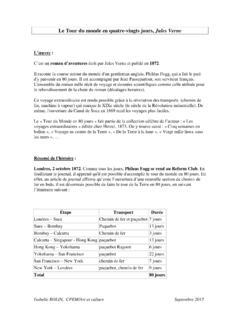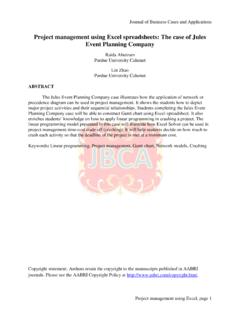Transcription of Translated with an Introduction and Notes by …
1 jules VERNE JOURNEY TO THE CENTRE OF THE EARTH Translated with an Introduction and Notes by William Butcher to sum up all the.. knowledge amassed by science, and to re-write the history of the universe. Thus Hetzel, Verne s publisher, ambitiously announced the aims of the se-ries the Extraordinary Journeys in the Known and Unknown Worlds, with which Verne launched his literary career. After Journey to the Centre of the Earth (1864) came such other masterpieces as The Adventures of Captain Hatteras, Twenty Thousand Leagues under the Sea, and Around the World in Eighty Days. Journey to the Centre of the Earth has been consistently praised for its style and vision of the world.
2 It explores the prehistory of the globe, but can also be read as a psychological quest, for the journey itself is as im-portant as arrival or discovery. Professor Lidenbrock and Axel travel across Iceland, and then down through an extinct crater towards a sun-less sea where they enter a living past and are confronted with the origins of man. A classic of nineteenth-century literature, the novel s distinctive combination of realism and Romanticism has marked figures as diverse as Sartre and Tournier, Mark Twain and Conan Doyle. extremely useful Modern Language Review a virtuoso exegete French Studies THE WORLD S CLASSICS JOURNEY TO THE CENTRE OF THE EARTH jules VERNE was born in Nantes in 1828, the eldest of five children in a prosperous family of French, Breton, and Scottish ancestry.
3 His early years were happy, apart from an unfulfilled passion for his cousin Caro-line. Literature always attracted him and while taking a law degree in Par-is he wrote a number of plays. His first book, about a journey to Scotland, was not published during his lifetime. However, in 1862, Five Weeks in a Balloon was accepted by the publisher Hetzel, becoming an immediate success. It was followed by Journey to the Centre of the Earth, Twenty Thousand Leagues under the Seas, Around the World in Eighty Days, and sixty other novels, covering the whole world (and below and beyond). Verne himself travelled over three continents, before suddenly selling his yacht in 1886.
4 Eight of the books appeared after his death in 1905 although they were in fact written partly by his son Michel. WILLIAM BUTCHER was formerly Head of the Language Centre at the Hong Kong Technical College. He has studied at Warwick, Lancaster, London, and the cole Normale Sup rieure, and has taught languages and pure mathematics in Malaysia, France, and Britain. As well as numerous arti-cles on French literature and natural language processing, he has pub-lished Mississippi Madness (1990), Verne s Journey to the Centre of the Self (1990), and critical editions of Verne s Humbug (1991), Backwards to Britain (1992), and Journey to the Centre of the Earth (1992) and Twenty Thousand Leagues under the Seas (1998) for Oxford World s Classics.
5 REVIEWS complete joy.. deeply moved by the language.. powerful translation.. brilliant , Extrapolation the first critical edition.. complete success.. invaluable.. no compa-rable French edition exists , BSJV superb.. a true pearl of a book , Professor Arthur Evans THE WORLD S CLASSICS jules VERNE Journey to the Centre of the Earth Translated with an Introduction and Notes by WILLIAM BUTCHER Oxford New York OXFORD UNIVERSITY PRESS 1992 [..] Translation, Introduction , Note on the Text and Translation, Select Bibli-ography, Chronology, Explanatory Notes , Appendices William Butcher 1992 The right of William Butcher to be identified as author of this work has been asserted by him in accordance with the Copyright, Designs, and Pa-tents Act 1988.
6 [..] CONTENTS Introduction Note on the Text and Translation Select Bibliography A Chronology of jules Verne JOURNEY TO THE CENTRE OF THE EARTH 1 Explanatory Notes Appendix: Verne as Seen by the Critics Introduction In France, jules Verne is not the same person as in Britain. South of the Channel, Verne is recognised as an authentic, nineteenth-century writer with a proper set of Collected Works. Since the 1960s, any sur-prise, condescension or irony at reading or studying the Voyages extraor-dinaires has disappeared, even among those who never actually buy any books. Balzac, Stendhal, Verne, Zola: the odd man out, the least inte-grated into Gallic national culture, is the Italianate Stendhal.
7 But in the English-speaking countries it is rare to meet adults who will admit to liking Verne. He is a children s author, a writer of science-fiction, a poor stylist, at best responsible for films starring James Mason. His works may be fiction, but certainly don t count as literature. He is short-trousered, not really French, and has nothing to say about the human condition . One reason for such a disparity must be the generally atrocious Eng-lish translations . The overwhelming majority of books by Djools Verne are leaden or wooden, and possibly infringe the Trade Descriptions Act.
8 They have lost up to half their contents, but have gained instead some wonderful howlers. There is no equivalent here to Baudelaire s Poe, or to Scott Moncrieff s Proust, with their textual thickness and their sense of overall belonging. Journey to the Centre of the Earth has been Translated more than ten times, but many are very poor indeed. The best-known version is still the atrocious 1872 one, which rebaptises Axel as Harry and Lidenbrock as Hardwigg, makes them both Scottish, and finishes each paragraph with at least one totally invented sentence. But this novel hardly deserves such treatment.
9 It was the first un-qualified critical success of Verne s and the first to be written under the close monitoring of his publisher and mentor Hetzel. Journey to the Cen-tre of the Earth is, above all, a brilliant piece of writing. It is an unparal-leled entertainment, but one that also stands comparison with other liter-ary works of the nineteenth century. The plot can be quickly summarised: Professor Lidenbrock and his nephew Axel discover a document in a twelfth-century Icelandic book which, when deciphered, records the claim of a certain Arne Saknussemm to have gone down into the carter of Snaefells and reached the centre of the Earth.
10 Lidenbrock decides to try this for himself and, dragging Axel away from his fianc e Gr uben, travels to Reykjavik and across Iceland. With the help of the stoical Hans, they find the crater and travel down through the geological layers of the past, experiencing various adven-tures. A long way down, they discover a huge caver containing a large sea plus various biological specimens, some dead and some very much alive. After trying to cross the sea, they discover a path down again, marked with Saknussemm s runic initials. But it is now blocked. They at-tempt to blow up the obstacle, while sheltering on the raft, but instead carry part of the sea with them down into the bowels of the Earth.








![[9] - ibiblio.org](/cache/preview/5/5/7/d/7/8/c/5/thumb-557d78c5e5b7e50924ac9fa19b799cb0.jpg)







